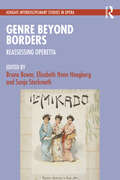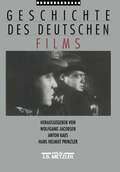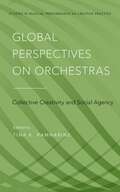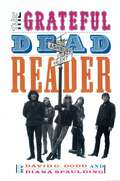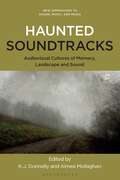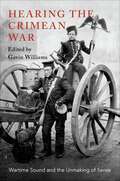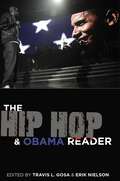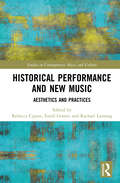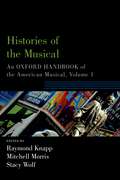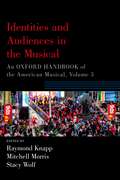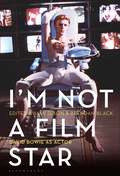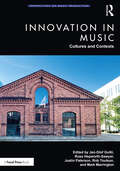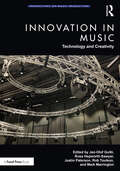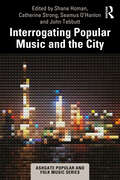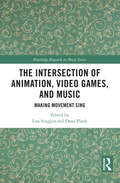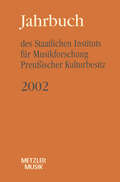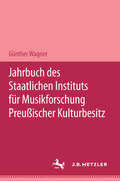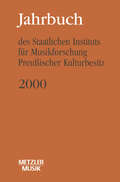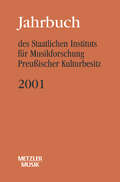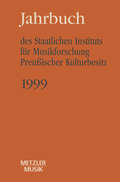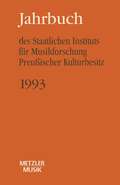- Table View
- List View
Genre Beyond Borders: Reassessing Operetta (Ashgate Interdisciplinary Studies in Opera)
This book offers an innovative approach to understanding operetta, drawing attention to its malleability and resistance to boundaries. These shows have traversed (and continue to traverse) with ease the national borders which might superficially define them, or draw on features from many other genres without fundamentally changing in tone or approach. The chapters move from nineteenth-century London and Paris to twentieth-century North America, South America and Europe to present-day Australia. Some offer fresh understandings of familiar composers, such as Johann Strauss or Gilbert and Sullivan, while others examine works or composers that are less well-known. The chapter on Socialist operetta in Czechoslovakia in particular will almost certainly be a revelation to anyone from Western Europe or the US, where operetta is often understood to be a bourgeois phenomenon. As a summary of the current state of the field, this collection showcases the many possible pathways for future scholars who wish to explore it.
Geschichte der musikalischen Interpretation im 19. und 20. Jahrhundert, Band 3: Aspekte - Parameter
Nachdem Band 1 Ästhetik und Ideengeschichte, Band 2 Institutionen und Medien der Interpretation thematisiert haben, befasst sich Band 3 mit der klingenden Interpretation selbst. Behandelt werden all jene Kategorien, die für Interpretation und ihre Wahrnehmung grundlegend sind: · Tempo und Tempomodifikationen, Dynamik, Phrasierung und Artikulation, Portamento und Vibrato, Textaussprache, Stimmung und Intonation.· die verwendeten Instrumente mit ihren spieltechnischen Möglichkeiten und Grenzen einschließlich der menschlichen Stimme· „Medien“ der Interpretation: Körper, Raum sowie die technischen Medien der Speicherung und Reproduktion, die Tonträger. Von fundamentaler Bedeutung ist ferner die Frage, in welchem Umfang man dem Notentext einer Komposition folgt bzw. von ihm abweicht („Willkürliche Veränderungen“, „Retuschen“, Ensemblekoordination), und welche Rolle regionale Differenzen bei der Interpretation spielen.
Global Perspectives on Orchestras: Collective Creativity and Social Agency (Studies in Musical Perf as Creative Prac)
Offering innovative approaches to thinking about orchestras, Global Perspectives on Orchestras: Collective Creativity and Social Agency adopts ethnographic, historical and comparative perspectives on a variety of traditions, including symphony, Caribbean steel, Indonesian gamelan, Indian film and Vietnamese court examples. The volume presents compelling analyses of orchestras in their socio-historical, economic, intercultural and postcolonial contexts, while emphasizing the global and historical connections between musical traditions. By drawing on new ethnographic and historical data, the essays describe orchestral creative processes and the politics shaping performance practices. Each essay considers how musicians work together in ensembles, focusing on issues such as training, rehearsal, creative choices, compositional processes, and organizational infrastructures. Testimonies of orchestral musicians highlight practitioners' views into the diverse world of orchestras. As a whole, the volume discusses the creative roles of performers, arrangers, composers and arts agencies, as well as the social environments supporting musical collaborations. With contributions from an international team of researchers, Global Perspectives on Orchestras offers critical insights gained from the study of orchestras, collective creativity and social agency, and the connections between orchestral performances, colonial histories, postcolonial practices, ethnographic writings and comparative theorizations.
The Grateful Dead Reader (Readers on American Musicians)
Arranged in chronological order, these pieces add up to nothing less than a full-scale history of the greatest tour band in the history of rock. From Tom Wolfe's account of the Dead's first performance as the Grateful Dead (at an Acid Test in 1965), to Ralph Gleason's 1967 interview with the 24-year-old Jerry Garcia, to Mary Eisenhart's obituary of the beloved leader of the band, these selections include not only outstanding writing on the band itself, but also superb pieces on music and pop culture generally. Fans will be fascinated by the poetry, fiction, drawings, and rare and revealing photographs featured in the book, as well as the anthology's many interviews and profiles, interpretations of lyrics, and concert and record reviews. Still, The Grateful Dead was more than a band--it was a cultural phenomenon. For three decades it remained on one unending tour, followed everywhere by a small army of nomadic fans. This phenomenon is both analyzed and celebrated here, in such pieces as Ed McClanahan's groundbreaking article in Playboy in 1972, fan-magazine editor Blair Jackson's 1990 essay on the seriousness of the drug situation at Dead concerts, and Steve Silberman's insightful essays on the music and its fans.
Haunted Soundtracks: Audiovisual Cultures of Memory, Landscape, and Sound (New Approaches to Sound, Music, and Media)
The turn of the millennium has heralded an outgrowth of culture that demonstrates an awareness of the ephemeral nature of history and the complexity underpinning the relationship between location and the past. This has been especially apparent in the shifting relationship between landscape, memory and sound in film, television and other media. The result is growing interest in soundtracks, as part of audiovisual culture, as well as an interest in the spectral aspects of culture more generally. This collection of essays focuses on audiovisual forms that foreground landscape, sound and memory. The scope of inquiry emphasises the ghostly qualities of a certain body of soundtracks, extending beyond merely the idea of 'scary films' or 'haunted houses.' Rather, the notion of sonic haunting is tied to ideas of trauma, anxiety or nostalgia associated with spatial and temporal dislocation in contemporary society. Touchstones for the approach are the concepts of psychogeography and hauntology, pervasive and established critical strategies that are interrogated and refined in relation to the reification of the spectral within the soundtracks under consideration here.
Hearing the Crimean War: Wartime Sound and the Unmaking of Sense
What does sound, whether preserved or lost, tell us about nineteenth-century wartime? Hearing the Crimean War: Wartime Sound and the Unmaking of Sense pursues this question through the many territories affected by the Crimean War, including Britain, France, Turkey, Russia, Italy, Poland, Latvia, Dagestan, Chechnya, and Crimea. Examining the experience of listeners and the politics of archiving sound, it reveals the close interplay between nineteenth-century geographies of empire and the media through which wartime sounds became audible--or failed to do so. The volume explores the dynamics of sound both in violent encounters on the battlefield and in the experience of listeners far-removed from theaters of war, each essay interrogating the Crimean War's sonic archive in order to address a broad set of issues in musicology, ethnomusicology, literary studies, the history of the senses and sound studies.
Hip Hop around the World [2 volumes]: An Encyclopedia [2 volumes]
This set covers all aspects of international hip hop as expressed through music, art, fashion, dance, and political activity.Hip hop music has gone from being a marginalized genre in the late 1980s to the predominant style of music in America, the UK, Nigeria, South Africa, and other countries around the world. Hip Hop around the World includes more than 450 entries on global hip hop culture as it includes music, art, fashion, dance, social and cultural movements, organizations, and styles of hip hop. Virtually every country is represented in the text. Most of the entries focus on music styles and notable musicians and are unique in that they discuss the sound of various hip hop styles and musical artists' lyrical content, vocal delivery, vocal ranges, and more. Many additional entries deal with dance styles, such as breakdancing or b-boying/b-girling, popping/locking, clowning, and krumping, and cultural movements, such as black nationalism, Nation of Islam, Five Percent Nation, and Universal Zulu Nation. Country entries take into account politics, history, language, authenticity, and personal and community identification. Special care is taken to draw relationships between people and entities such as mentor-apprentice, producer-musician, and more.
The Hip Hop & Obama Reader
Featuring a foreword by Tricia Rose and an Afterword by Cathy J. Cohen Barack Obama flipped the script on more than three decades of conventional wisdom when he openly embraced hip hop--often regarded as politically radioactive--in his presidential campaigns. Just as important was the extent to which hip hop artists and activists embraced him in return. This new relationship fundamentally altered the dynamics between popular culture, race, youth, and national politics. But what does this relationship look like now, and what will it look like in the decades to come? The Hip Hop & Obama Reader attempts to answer these questions by offering the first systematic analysis of hip hop and politics in the Obama era and beyond. Over the course of 14 chapters, leading scholars and activists offer new perspectives on hip hop's role in political mobilization, grassroots organizing, campaign branding, and voter turnout, as well as the ever-changing linguistic, cultural, racial, and gendered dimensions of hip hop in the U.S. and abroad. Inviting readers to reassess how Obama's presidency continues to be shaped by the voice of hip hop and, conversely, how hip hop music and politics have been shaped by Obama, The Hip Hop & Obama Reader critically examines hip hop's potential to effect social change in the 21st century. This volume is essential reading for scholars and fans of hip hop, as well as those interested in the shifting relationship between democracy and popular culture.
Historical Performance and New Music: Aesthetics and Practices
The worlds of new music and historically informed performance might seem quite distant from one another. Yet, upon closer consideration, clear points of convergence emerge. Not only do many contemporary performers move easily between these two worlds, but they often do so using a shared ethos of flexibility, improvisation, curiosity, and collaboration—collaboration with composers past and present, with other performers, and with audiences. Bringing together expert scholars and performers considering a wide range of issues and case studies, Historical Performance and New Music—the first book of its kind—addresses the synergies in aesthetics and practices in historical performance and new music. The essays treat matters including technologies and media such as laptops, printing presses, and graphic notation; new music written for period instruments from natural horns to the clavichord; personalities such as the pioneering singer Cathy Berberian; the musically “omnivorous” ensembles A Far Cry and Roomful of Teeth; and composers Luciano Berio, David Lang, Molly Herron, Caroline Shaw, and many others. Historical Performance and New Music presents pathbreaking ideas in an accessible style that speaks to performers, composers, scholars, and music lovers alike. Richly documented and diverse in its methods and subject matter, this book will open new conversations about contemporary musical life.
Histories of the Musical: An Oxford Handbook of the American Musical, Volume 1 (Oxford Handbooks)
The American musical is a paradox. On stage or screen, musicals at once hold a dominant and a contested place in the worlds of entertainment, art, and scholarship. Born from a mélange of performance forms that included opera and operetta, vaudeville and burlesque, minstrelsy and jazz, musicals have always sought to amuse more than instruct, and to make money more than make political change. In spite of their unapologetic commercialism, though, musicals have achieved supreme artistry and have influenced culture as much as if not more than any other art form in America, including avant-garde and high art on the one hand, and the full range of popular and commercial art on the other. Reflecting, refracting, and shaping U.S. culture since the early twentieth century, musicals converse with shifting dynamics of gender and sexuality, ethnicity and race, and the very question of what it means to be American and to be human. The chapters gathered in this book, Volume I of the reissued Oxford Handbook, explore the American musical from both the outside and the inside. This first volume concentrates in particular on large-scale, more philosophical issues of relevance to the genre, considering issues of historical situations and formal procedure as they bear on the narratives we make concerning productions and performers, artists and audiences, commerce and context. The first four essays discuss ways of defining histories and texts, and apprehending the formal choices of singers and dancers; the second group of four take up the subtle challenges of the genre's signal transformations out of minstrelsy and Tin Pan Alley to "integration" and beyond.
Historische Musikwissenschaft: Grundlagen und Perspektiven
Grundsätzliches und Interdisziplinäres. Welches sind die Fragen und Methoden der Historischen Musikwissenschaft? Und im Rahmen aktueller Debatten in Kunst-, Literatur- und Kulturwissenschaft: Kann sie damit Anschluss an diese Disziplinen finden? Die Autoren des Bandes erörtern musikalische und musikwissenschaftliche Phänomene aus Geschichte und Gegenwart und erproben Zugänge aus historischer, soziologischer, ästhetischer, medientheoretischer, philologischer oder kulturwissenschaftlicher Sicht.
Identities and Audiences in the Musical: An Oxford Handbook of the American Musical, Volume 3 (Oxford Handbooks)
Issues of identity have always been central to the American musical in all its guises. Who appears in musicals, who or what they are meant to represent, and how, over time, those representations have been understood and interpreted, provide the very basis for our engagement with the genre. In this third volume of the reissued Oxford Handbook of the American Musical, chapters focus on race, ethnicity, gender, and sexuality, regional vs. national identity, and the cultural and class significance of the musical itself. As important as the question of who appears in musicals are the questions of who watches and listens to them, and of how specific cultures of reception attend differently to the musical. Chapters thus address cultural codes inherent to the genre, in particular those found in traditional school theater programs.
I’m Not a Film Star: David Bowie as Actor
The first collection dedicated to David Bowie's acting career shows that his film characterisations and performance styles shift and reform as decoratively as his musical personas. Though he was described as the most influential pop artis of the 20th century, whose work became synonymous with mask, mystery, sexual excess and ch-ch-ch-changing genres, Bowie also applied his genius to the craft of acting.Bowie's considerable filmography is systematically examined in 12 scholarly essays that include tributes to Bowie's performance craft in other media forms. Classic films such as The Prestige and Merry Christmas, Mr. Lawrence, cult hits Labyrinth and The Man Who Fell To Earth, as well as lesser-known roles in The Image, Christiane F. and Broadway hit The Elephant Man are viewed, not simply through the lens of Bowie's mega-stardom, but as the work of a serious actor with inimitable talent. This compelling analysis celebrates the risk-taking intelligence and bravura of David Bowie: actor, mime, mimic and icon.
Individualität in der Musik
Musiktheoretische und musikwissenschaftliche, produktionsästhetische und aufführungspraktische, philosophische und semiotische Aspekte des Individualitätsbegriffes werden in neun, jeweils zwei bis vier Beiträge enthaltenden Sektionen beleuchtet. Zur Sprache kommen dabei u. a. die Faszinationskraft des Individuellen, Individuation als Prozess der Werkgenese und als dem Werk eingeschriebene musikalische Bewegung, das Verhältnis von Individualität und Norm, die Beziehung zwischen musikalischer Zeit und lebenszeitlicher Erfahrung, Negation und Reduktion des Individuellen in Werken des 20. Jahrhunderts sowie ökonomische Aspekte des Individualitätsbegriffs. Mit diesem aus einem Symposion der Berliner Hochschule der Künste und der TU Berlin hervorgegangenen Band setzen die Herausgeber von »Klang Struktur Metapher. Musikalische Analyse zwischen Phänomen und Begriff« ihr Konzept fort, junge KomponistInnen und WissenschaftlerInnen aus verschiedenen Disziplinen in der Diskussion eines Themas von fachübergreifender Relevanz zusammenzuführen.
Innovation in Music: Cultures and Contexts (ISSN)
Innovation in Music: Cultures and Contexts is a groundbreaking collection bringing together contributions from instructors, researchers, and professionals. Split into two sections, covering creative production practices and national/international perspectives, this volume offers truly global outlooks on ever-evolving practices.Including chapters on Dolby Atmos, the history of distortion, creativity in the pandemic, and remote music collaboration, this is recommended reading for professionals, students, and researchers looking for global insights into the fields of music production, music business, and music technology.
Innovation in Music: Technology and Creativity (ISSN)
Innovation in Music: Technology and Creativity is a groundbreaking collection bringing together contributions from instructors, researchers, and professionals. Split into two sections, covering composition and performance, and technology and innovation, this volume offers truly international perspectives on ever-evolving practices.Including chapters on audience interaction, dynamic music methods, AI, and live electronic performances, this is recommended reading for professionals, students, and researchers looking for global insights into the fields of music production, music business, and music technology.
Interrogating Popular Music and the City (ISSN)
How does popular music influence the culture and reputation of a city, and what does a city do to popular music? Interrogating Popular Music and the City examines the ways in which urban environments and music cultures intersect in various locales around the globe. Music and cities have been partners in an often clumsy, sometimes accidental but always exciting dance. Heritage and immigration, noise and art, policy and politics are some of the topics that are addressed in this critical examination of relationships between cities and music. The book draws upon an international array of researchers, encompassing hip hop in Beijing; the city favelas of Brazil; from Melbourne bars to European parliaments; to heritage and tourism debates in Salzburg and Manchester. In doing so, it interrogates the different agendas of audiences, musicians and policy-makers in distinct urban settings.
The Intersection of Animation, Video Games, and Music: Making Movement Sing (Routledge Research in Music)
In both video games and animated films, worlds are constructed through a combination of animation, which defines what players see on the screen, and music and sound, which provide essential cues to action, emotion, and narrative. This book offers a rich exploration of the intersections between animation, video games, and music and sound, bringing together a range of multidisciplinary lenses. In fourteen chapters, the contributors consider similarities and differences in how music and sound structure video games and animation, as well as the animation within video games, and explore core topics of nostalgia, adaptation, gender and sexuality. Offering fresh insights into the aesthetic interplay of animation, video games, and sound, this volume provides a gateway into new areas of study that will be of interest to scholars and students across musicology, animation studies, game studies, and media studies more broadly.
Jahrbuch des Staatlichen Instituts für Musikforschung Preußischer Kulturbesitz 2002
Das in Kiew wiederaufgefundene und im Dezember 2001 nach Berlin zurückgekehrte Notenarchiv der Sing-Akademie ist - mit Beiträgen von Ch. Wolff, H. Hell, G. Wagner, P. Wollny, Ch. Henzel und U. Leisinger - einer der Schwerpunkte des neuen Jahrbuchs. Weitere Beiträge - über R. Strauss' Neuausgabe von Berlioz' Instrumentationslehre sowie den Wiener Kontrabaß - dokumentieren die Arbeit im Musikinstrumenten-Museum bzw. befassen sich am Beispiel von Vincenzo Righini, Hans Pfitzner und Ernst Pepping mit Stationen der Musikgeschichte Berlins. Ein letzter Schwerpunkt gilt der Geschichte musikwissenschaftlicher Institutionen in Wien, München und an den preußischen Universitäten in den 1880er Jahren.
Jahrbuch des Staatlichen Instituts für Musikforschung Preußischer Kulturbesitz 2003
Im Mittelpunkt des Jahrbuchs 2003 stehen mehrere Beiträge über das wiederaufgefundene Notenarchiv der Sing-Akademie zu Berlin. Weitere Aufsätze widmen sich u.a. dem Begriff "Berliner Klassik", Kompositionen von Fanny Hensel und W. A. Mozart sowie dem "Violinkonzert" von Alban Berg.
Jahrbuch des Staatlichen Instituts für Musikforschung (SIM) Preußischer Kulturbesitz: 2000
Die historische Aufführungspraxis ist das zentrale Thema des Jahrbuchs 2000. Das Spektrum reicht dabei vom Frühbarock bis zum 19. Jahrhundert. Claudia Theis und Nicole Restle beschäftigen sich mit den großbesetzten Werken Johann Hermann Scheins, Peter Wollny mit Bachs Nachfolger Gottlob Harrer, Christoph Wolff mit der Frage, wie »die ehemalige Arth von Music« im Falle Bachs geklungen hat. Mit dem Wandel der Rezeptionsvoraussetzungen der Barockmusik im 19. Jahrhundert beschäftigen sich Robert Hill, Konstantin Restle und Günther Wagner. Beiträge von Nors S. Josephson (über Form- und Strukturprobleme im Schaffen Bachs) sowie von Christoph Henzel (über die Berliner Hofmusik zur Zeit Friedrichs II.) runden diesen Teil ab. Ergänzt wird dieser Schwerpunkt durch Aufsätze von Reinhold Brinkmann über die Wirkung Max Regers sowie von Julia Wechsler über Opernpläne Alban Bergs.
Jahrbuch des Staatlichen Instituts für Musikforschung (SIM) Preußischer Kulturbesitz: 2001
Die Musikgeschichte Berlins in der zweiten Hälfte des 18. Jahrhunderts ist einer der Schwerpunkt des neuen Jahrbuchs. Walter Salmen beschäftigt sich mit dem Wirken des Hofkapellmeisters Johann Friedrich Reichardt; Norbert Miller reflektiert die Sonderstellung Berlins im Hinblick auf Klassizismus und frühe Romantik. Ulrich Leisinger beschäftigt sich mit Wilhelm Friedrich Ernst Bach, dem letzten musikalisch bedeutenden Nachfahren des Thomaskantors, Günther Wagner mit Carl Philipp Emanuel Bachs Wirken in Potsdam und Berlin zwischen 1740 und 1768. Mehrere Beiträge, u.a. von Christian Ahrens, Konstantin Restle, Wolf Dieter Neupert, Sabine Hoffmann, Gerhart Darmstadt und Thomas Schiegnitz sind Fragen des historischen Musikinstrumentenbaus gewidmet. Abgeschlossen wird der Band durch Aufsätze zur Figurenlehre (Janina Klassen, Heinz von Loesch) und zur Stadt als Raum und Ideengeber für den Komponisten (Martin Elste).
Jahrbuch des Staatlichen Instituts für Musikforschung (SIM) Preußischer Kulturbesitz: 1997
Das Jahrbuch 1999 hat drei inhaltliche Schwerpunkte: die Musik der Bach-Zeit, Formkategorien in Instrumentalwerken des Fin de Siècle und der Neuen Musik sowie die instrumentenkundliche Forschung des Instituts.
